|
|
Editorial: Green Conversion of CO2
OUYANG Shuxin, WANG Wenzhong
2022 Vol. 37 (1): 1–2
 Abstract
Abstract(
610 )
 HTML
HTML(
35)
 PDF
PDF(351KB)(
835
)
With the continuous progress of global industrialization, fossil fuels have been over-consumed, which results in a large amount of CO2 discharged into the atmosphere and therefore causes negative effects such as global warming and ecological imbalance. Reducing CO2 emissions and converting recycled CO2 to value added chemicals have become important tasks. Around 2010, led by United States of America, followed by Europe and Japan, tens of countries started their national scientific research projects entitled “artificial photosynthesis”, with an investment as much as 100 million USDs. Since 2011, China has also funded similar projects by the National Natural Science Foundation of China and the Ministry of Science and Technology. In September of 2020, the Chinese government even put forward the goal of “carbon emission peak” by 2030 and “carbon neutrality” by 2060.
Green plants or microorganisms make organics from CO2 and H2O through “photosynthesis”. The photocatalysts can convert CO2 and H2O/H2 into fuels or chemicals under light irradiation, which simulates the natural “photosynthesis” and is entitled as “artificial photosynthesis”. Nevertheless, the conversion of CO2 is not limited to be driven by solar energy; alternatively, the electricity generated by non-fossil fuels to drive efficient electrocatalytic or thermocatalytic CO2 reduction is also a feasible way. At present, the hot spots in basic research are photocatalysis, photothermocatalysis and electrocatalysis for CO2 reduction. “Green conversion of CO2” defines the technological approaches with at least one of the features of low energy consumption, low environmental load and high efficiency, which enables them competitive in future industrial applications.
In recent years, the study on CO2 conversion has made rapid progresses, but some key problems are still to be solved. Photocatalysis provides the mildest way to convert CO2 into fuels or chemicals, which means the lowest cost in the future application, but currently faces great challenge in efficiency and stability. Not until photothermocatalytic CO2 reduction was reported in 2014, it has attracted extensive attention. The catalysts realize light-to-thermal conversion and subsequently drive thermocatalysis. Compared with photocatalysis, the efficiency and stability of photothermocatalytic CO2 reduction are significantly increased, but the consumption of H2 as feedstock will result in additional cost. Electrocatalytic CO2 reduction is also a mild process, and its energy utilization efficiency is the highest among three methods. However, due to the reaction environment of aqueous solution, there inevitably occurs the competition of CO2 reduction and proton reduction; therefore, the improvement of product selectivity is still faced with a bottleneck. Moreover, the separation of liquid or gas phase products somewhat increases production cost. Importantly, the economy of CO2 conversion should take account of the yield of value-added product. The products of photocatalysis and electrocatalysis mainly concentrated in C1 chemicals (mainly including carbon monoxide, methane, methanol, formic acid salt,etc.), and a few studies reported the production of ethane. However, the photothermocatalysis exhibits superior advantage in this aspect; for instance, the Fischer-Tropsch synthesis with CO2 and H2 as feedstocks to produce C2 - C7 products has been reported. Each technological approach has its own advantages but faces different scientific or technical difficulties, which may complement each other and show its strengths in different application fields in the future.
Shortly after China put forward the goal of “carbon emission peak” and “carbon neutrality”, the editorial board ofJournal of Inorganic Materialsorganizes the special issue on “Green Conversion of CO2”. Although the investigation on CO2 conversion has made great progress, but still faces various challenges. Looking forward to that more researchers devote to this study to promote it from the basic research to the industrial application, our continuous effort will make our country reverse the disadvantage of terrible carbon emission to the advantage of converting recycled CO2 to resources effectively.

|
|
|
Recent Progress on Photocatalytic CO2 Reduction with Ultrathin Nanostructures
GAO Wa, XIONG Yujie, WU Congping, ZHOU Yong, ZOU Zhigang
2022 Vol. 37 (1): 3–14
 Abstract
Abstract(
777 )
 HTML
HTML(
56)
 PDF
PDF(11172KB)(
1260
)
Since the beginning of the 21st century, energy shortage and environmental pollution have been the major challenges faced by human beings. Photocatalytic carbon dioxide (CO2) reduction is one of the promising strategies to solve the energy crisis and promote the carbon cycle, in which semiconductor captures solar energy to obtain hydrocarbon fuel. However, the low activity and poor selectivity of the products greatly limit the practical application of this technology. Thus, it is of great significance to regulate product selectivity, improve photocatalytic efficiency, and deeply understand the mechanism of CO2 reduction reaction. In recent years, ultrathin materials have attracted extensive attention from researchers due to their high specific surface area, abundant unsaturated coordination surface atoms, shortened charge migration path from inside to surface, and tailorable energy band structure, and have achieved promising results in the field of photocatalytic CO2 reduction. In this paper, the reaction mechanism of photocatalytic CO2 reduction is firstly summarized. Next, the research results of promoting electron hole separation and regulating charge transport path of ultrathin nanostructures by constructing heterostructures, designing Z-scheme systems, introducing co-catalysts, and defect engineering are introduced. Finally, the prospect and challenge of improving the efficiency of photocatalytic CO2 reduction and optimizing the product selectivity are pointed out.
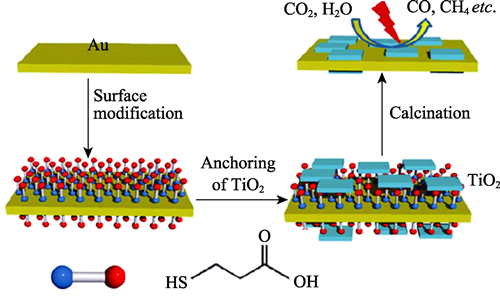
|
|
|
Synthesis of Zn0.4(CuGa)0.3Ga2S4/CdS Photocatalyst for CO2 Reduction
LIU Peng, WU Shimiao, WU Yunfeng, ZHANG Ning
2022 Vol. 37 (1): 15–21
 Abstract
Abstract(
545 )
 HTML
HTML(
37)
 PDF
PDF(1991KB)(
809
)
Conversion of CO2 into fuels by photocatalysis is promising in solving the energy crisis and the greenhouse effect. Among various photocatalytic materials, Zn1-2x(CuGa)xGa2S4 materials possess visible light response and high conduction band potential, which are ideal CO2 reduction materials from thermodynamics aspect. However, their photocatalytic CO2 reduction activity is still low which is urgent to improve its activity in terms of kinetics. In this study, Zn0.4(CuGa)0.3Ga2S4 was synthesized and composited with CdS nanoparticles with different proportions to form Zn0.4(CuGa)0.3Ga2S4/CdS heterojunction photocatalysts. A series of characterizations suggest that CdS is uniformly grown on surface of Zn0.4(CuGa)0.3Ga2S4 microcrystals to form a Z-scheme type all-solid heterojunction composite materials. Such a structure effectively suppresses the recombination of electron-hole pairs and improve the photocatalytic performance. In the solution CO2 reduction system, the as-prepared Zn0.4(CuGa)0.3Ga2S4/CdS can effectively reduce CO2 into CO under visible light irradiation. The optimal molar ratio of Zn0.4(CuGa)0.3Ga2S4 and CdS in composite materials is 2 : 1, whose photocatalytic performance is 1.7 times of that of Zn0.4(CuGa)0.3Ga2S4/ CdS and 1.6 times of that of CdS. This work constructs all solid Z-scheme type Zn0.4(CuGa)0.3Ga2S4/CdS heterojunction materials with enhanced photocatalytic activity for CO2 reduction, which is promising for designing novel photocatalysts in field of artificial photosynthesis.
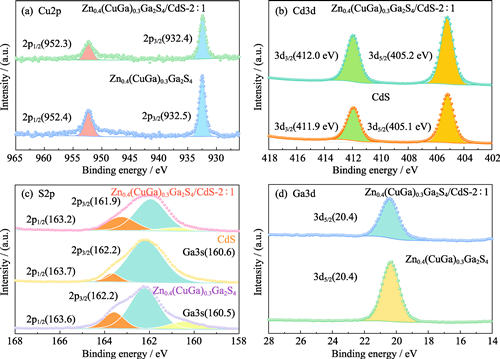
|
|
|
Preparation and Photothermal Catalytic Application of Powder-form Cobalt Plasmonic Superstructures
WANG Xiao, ZHU Zhijie, WU Zhiyi, ZHANG Chengcheng, CHEN Zhijie, XIAO Mengqi, LI Chaoran, HE Le
2022 Vol. 37 (1): 22–28
 Abstract
Abstract(
722 )
 HTML
HTML(
32)
 PDF
PDF(3352KB)(
942
)
Highly light absorptive photocatalysts are of great significance to boost the photothermal conversion efficiency. Light trapping effect of nanoarray structured photothermal catalysts can enhance the light absorption and improve the photothermal conversion efficiency. However, the practical applications of array-based catalysts are hindered by very low loadings of active metal catalysts per unit illumination area. Herein, we develop a SiO2-protected MOFs pyrolysis method for the preparation of powder-form cobalt plasmonic superstructures that enable a 90% absorption efficiency of sunlight and tunable metal loading per unit area. Its high light absorption capacity was confirmed by time-domain finite-difference simulation calculations due to the plasmonic hybridization effect of nanoparticles. Compared with nanoarray-structured plasmonic superstructures, the powder-form catalyst exhibit enhanced catalytic activity and stability, resulting in the increase of CO2 conversion efficiency from 0.9% to 26.2%. This study lays the foundation for the practical application of non-precious metal photothermal catalysts.
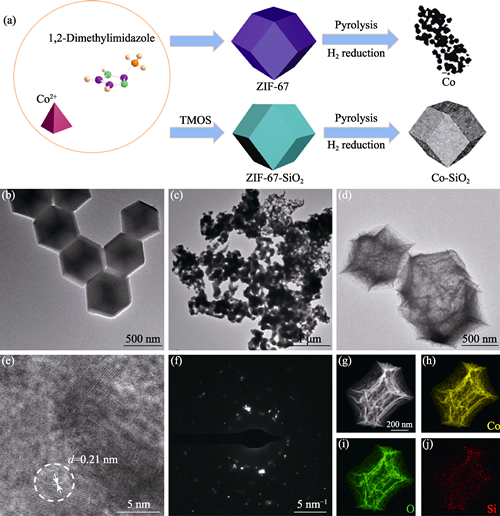
|
|
|
Modulation of CuO Surface Properties for Selective Electrocatalytic Reduction of CO2 to HCOOH
GUO Lina, HE Xuebing, LYU Lin, WU Dan, YUAN Hong
2022 Vol. 37 (1): 29–37
 Abstract
Abstract(
767 )
 HTML
HTML(
43)
 PDF
PDF(1192KB)(
983
)
The electrocatalytic carbon dioxide reduction reaction can convert the greenhouse gas carbon dioxide into chemical raw materials or organic fuels, providing a feasible way to overcome global warming and the conversion of electrical energy to chemical energy. The main challenge of this technology is the wide product distribution, resulting in low selectivity of a single product, however, modulating the surface properties of the catalyst is an efficient strategy to solve this problem. In this study, the precursors of Cu2O and Cu2S were oxidized to the CuO catalysts with different surface properties. The CuO-FS catalyst derived from Cu2S delivered the improved activity of electro-reduction of carbon dioxide and selectivity for formic acid product. This catalyst exhibited a higher total current density and the Faraday efficiency of formic acid > 70% in a wide test voltage range of -0.8 - -1.1 V; the Faraday efficiency for formic acid could reach a maximum of 78.4% at -0.9 V. The mechanism study indicated that the excellent performance of CuO-FS for electro-reduction of carbon dioxide could be attributed to the large electrochemically active surface area, which provided a large number of surface active sites, resulting in a higher total current density; moreover, the less zero-valent Cu was produced over the surface of CuO-FS during the electrocatalytic process, which reduced the production of ethylene and thus promoted the production of formic acid.
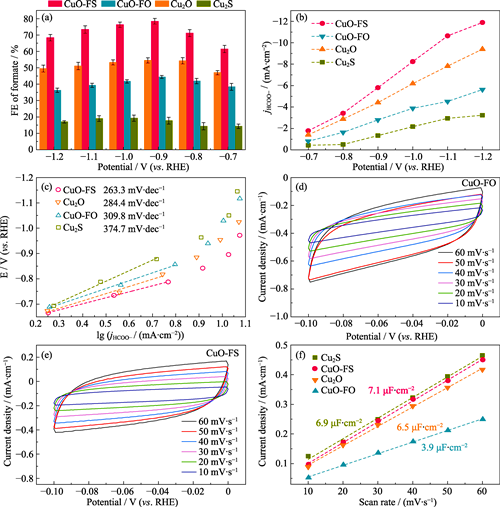
|
|
|
Selective Oxidation of Biomass over Modified Carbon Nitride Photocatalysts
LIU Xuechen, ZENG Di, ZHOU Yuanyi, WANG Haipeng, ZHANG Ling, WANG Wenzhong
2022 Vol. 37 (1): 38–44
 Abstract
Abstract(
382 )
 HTML
HTML(
30)
 PDF
PDF(1505KB)(
895
)
Using carbon nitride photocatalysts to catalyze the selective conversion of biomass platform molecules could not only expand the application fields of non-metallic catalysts but also alleviate the dependence on fossil energy in chemical manufacturing. 2,5-diformylfuran is an indispensable intermediate for the production of value-added chemicals. In this study, pyromellitic dianhydride and melem were used as the precursors. The pyromellitic dianhydride monomer was incorporated into the carbon nitride skeleton by high-temperature heat-treatment, and the catalysts were further treated with H2O2. Finally non-metallic carbon nitride photocatalysts containing nitrogen hydroxyl groups were prepared. Moreover, its performance in the selective oxidation of 5-hydroxymethylfurfural into 2,5-diformylfuran under visible light excitation was investigated. The results showed that H2O2-treated samples could generate nitroxide radicals under light irradiation, resulting in the selective oxidation of hydroxyl groups on the side chains of 5-hydroxymethylfurfural molecules into aldehyde groups, avoiding undesired side-reactions (ring-opening, mineralization reactions, etc.) caused by various reactive oxygen species that may be generated in aqueous solutions. In particular, under the excitation of an LED light source with a specific wavelength (400 nm), when the ratio of melem to PMDA precursor was 1 : 2, the selectivity of 2,5-diformylfuran over the photocatalyst could reach 96.2%.
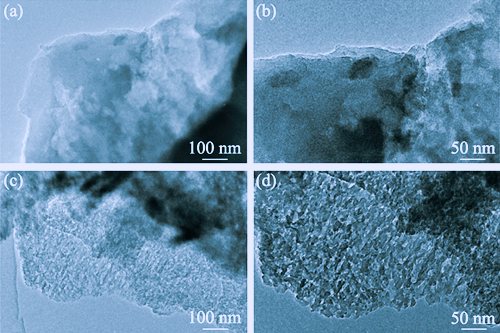
|
|
|
Iron-doping Enhanced Basic Nickel Carbonate for Moisture Resistance and Catalytic Performance of Ozone Decomposition
LI Bangxin, ZHANG Qian, XIAO Jie, XIAO Wenyan, ZHOU Ying
2022 Vol. 37 (1): 45–50
 Abstract
Abstract(
526 )
 HTML
HTML(
16)
 PDF
PDF(1889KB)(
810
)
Ozone pollution is taking more dominant position in China than PM2.5, traditional ozonolysis catalytic materials have limited performance in humid conditions. In this study, an iron-doped basic nickel carbonate catalyst (NiCH-Fe) was successfully fabricated via a facile hydrothermal method, which could stably decompose 2.14 μg/L ozone at 60% relative humidity for 12 h with nearly 100% removal ratio. The result of the Quartz Crystal Microbalance test showed that the water molecules adsorbed on the surface of NiCH-Fe were significantly reduced as compared with that adsorbed on pure NiCH, which were favorable for the competitive adsorption of ozone. Density functional theory results proved that Fe atoms were new sites instead of Ni atoms and had stronger adsorption capacity for ozone molecules. In addition, the XPS results demonstrated that the iron atoms serving as active sites were substantially stable in the reaction. Therefore, material doped with Fe provided excellent moisture resistance and long-term stability. This work provides an effective technical method for the development of materials with high moisture resistance ability for efficient ozone catalytic decomposition.
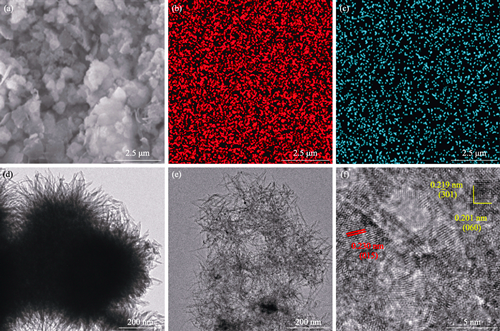
|
|
|
Vacancy on Structures, Mechanical and Electronic Properties of Ternary Hf-Ta-C System: a First-principles Study
PENG Junhui, TIKHONOV Evgenii
2022 Vol. 37 (1): 51–57
 Abstract
Abstract(
392 )
 HTML
HTML(
19)
 PDF
PDF(1805KB)(
812
)
In this study, the first-principles method was used to predict the vacancy ordered structures of ternary Hf-Ta-C system and the effect of vacancy on its mechanical properties. Crystal structure of (Hf, Ta)C1-x under ambient pressure were predicted by first-principles evolutionary using USPEX software. This calculation found 5 stable and 3 metastable vacancy ordered structures which all share the rock-salt structure. Then, mechanical properties of (Hf, Ta)C1-x vacancy ordered structures were calculated by the first-principles method, and change of mechanical properties with the concentration of vacancy was analyzed. They all showed high bulk modulus, shear modulus, elastic modulus, and Vickers hardness. Their moduli and hardness decreased with the increase of the concentration of vacancy at the same Hf/Ta ratio. Finally, their electronic density of states are calculated, revealing that their chemical bonding is a mixture of strong covalence and weak metallic. Data from this study are promising for understanding vacancy ordered structures, mechanical properties and applications of Hf-Ta-C system.
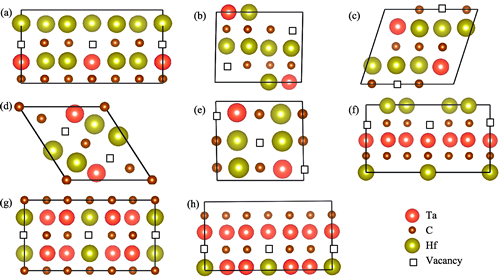
|
|
|
Synthesis, Electronic Structure and Visible Light Photocatalytic Performance of Quaternary BiMnVO5
ZHANG Xian, ZHANG Ce, JIANG Wenjun, FENG Deqiang, YAO Wei
2022 Vol. 37 (1): 58–64
 Abstract
Abstract(
391 )
 HTML
HTML(
22)
 PDF
PDF(1790KB)(
819
)
Removal of organic pollutants from water bodies by photocatalysis has broad application prospects in the field of sewage purification. In this study, the quaternary BiMnVO5 was synthesized by hydrothermal method and solid-state reaction, respectively. The morphology, structure and optical properties of the catalysts were characterized, and the electronic structure was calculated. Results showed that the hydrothermal method can rapidly synthesize pure BiMnVO5 with high crystallinity. BiMnVO5 is a semiconductor with a direct band gap of 1.8 eV, which is consistent with the results of first-principles calculations. Analysis of the density of states further reveals that the optical absorption band are attributed to the transitions from Mn3d/O2p to V3d. The photocatalytic results show that the BiMnVO5 synthesized by hydrothermal method exhibits the highest catalytic activity. About 98% Methylene Blue (MB) is degraded when exposed to visible light for 4 h. The hydroxyl radicals and photo-generated holes are proved to be the main active substances in the photocatalytic process. After 5 cycles, it still maintains capacity of degrading 85% MB in 4 h under visible light irradiation, while its morphology and structure remain unchanged, which indicates BiMnVO5 a good photocatalyst with reliable stability.
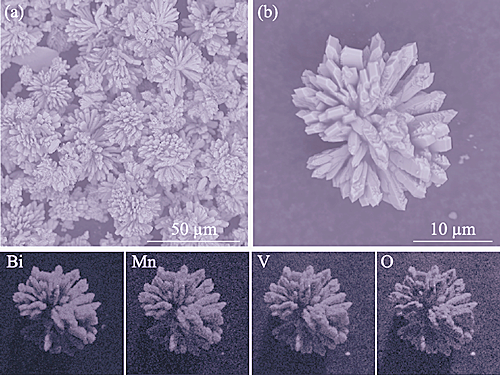
|
|
|
Decomposition of Cyclohexyl Hydroperoxide Catalyzed by Core-shell Material Co3O4@SiO2
CHEN Xiaomei, CHEN Ying, YUAN Xia
2022 Vol. 37 (1): 65–71
 Abstract
Abstract(
408 )
 HTML
HTML(
16)
 PDF
PDF(3680KB)(
766
)
Decomposition of cyclohexyl hydroperoxide (CHHP) is an important step in the preparation of cyclohexanol and cyclohexanone by non-catalytic oxidation of cyclohexane. Using Co3O4 nanoparticles as the core, cetyltrimethylammol/lonium bromide (CTAB) as the template and tetraethyl orthosilicate (TEOS) as the silicon source, the core-shell structure material Co3O4@SiO2 was synthesized by template method. The effects of the preparation conditions for SiO2 shells on the structure of core-shell material were investigated, such as the ratio of ethanol to water, the concentration of CTAB and the amount of TEOS. Textural properties of the materials were characterized by different techniques. Meanwhile, the catalytic performance and stability of the materials were evaluated on the decomposition reaction of CHHP. All results showed that the materials with thin shell and high porosity exhibited a preferable catalytic performance, and the conversion of CHHP was 81.68% and the selectivity of cyclohexanol and cyclohexanone was 70.60% and 34.06%, respectively. This core-shell structure could protect the activity of the core Co3O4 and significantly decrease the loss of cobalt element. However, there existed different degree of the fragmentation of SiO2 shell in the recycling process of Co3O4@SiO2 samples.
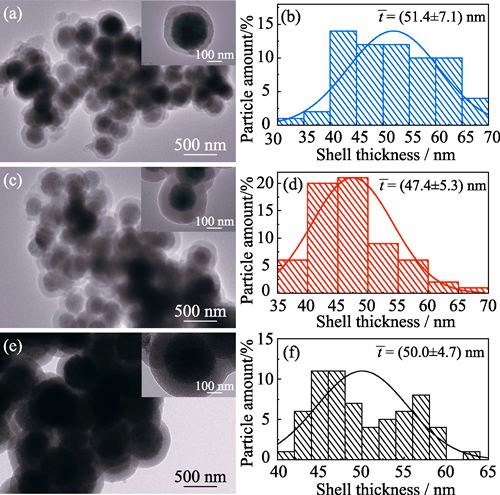
|
|
|
4-Chlorobenzylamine-based 2D/3D Perovskite Solar Cells
YANG Xinyue, DONG Qingshun, ZHAO Weidong, SHI Yantao
2022 Vol. 37 (1): 72–78
 Abstract
Abstract(
846 )
 HTML
HTML(
73)
 PDF
PDF(1770KB)(
1138
)
Defects at the surface and grain boundary of the three-dimensional (3D) organic-inorganic metal halide perovskite film incline to cause non-radiative recombination of charge carriers and accelerate decomposition of 3D perovskite, in turn deteriorating the power conversion efficiency (PCE) and stability of the perovskite solar cells (PSCs). In this study, the organic 4-chlorobenzylamine cation was applied to react with 3D perovskite and the residual PbI2 to in-situ form a two-dimensional (2D) perovskite top layer, which can passivate the surface and grain boundary defects of the 3D perovskite film, and improve the surface hydrophobicity. Based on this strategy, 2D/3D-PSCs with higher PCE and better stability were successfully obtained. Their structure, morphology photoelectric propery and stability of PSCs were systematically studied. All results show that 2D/3D-PSCs achieve PCEs up to 20.88%, much higher than that of 18.70% for the 3D-PSCs. In addition, 2D/3D-PSCs can maintain 82% of the initial PCE after 200 h continuous operation under 1-sun illumination in N2 atmosphere, exhibiting excellent stability.
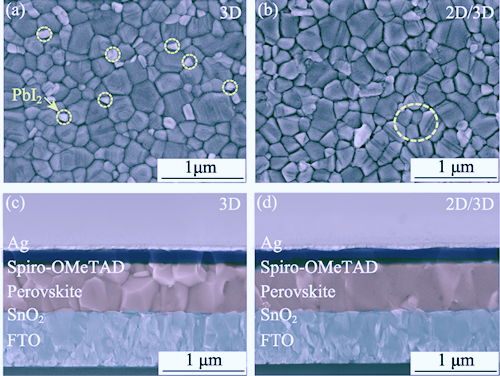
|
|
|
Preparation and Physical Property of BTO-based Multiferroic Ceramics
LI Sheng, SONG Guoqiang, ZHANG Yuanyuan, TANG Xiaodong
2022 Vol. 37 (1): 79–85
 Abstract
Abstract(
554 )
 HTML
HTML(
15)
 PDF
PDF(639KB)(
851
)
Multiferroic material is one of hot spots in the materials research area which can be widely used in many new functional devices. Barium titanate (BaTiO3, BTO) has attracted many interests for its multiferroic properties, such as ferroelectricity, high dielectric constant and electro-optical properties at room temperature. The BaTi0.94(TM1/2Nb1/2)0.06O3 (TM=Mn/Ni/Co) ceramic samples were prepared by solid state reaction method, and their structure, electrical, magnetic, and optical properties were systematically studied. The crystal structure of all doped samples changes from tetragonal to cubic phase without any hexagonal phase depending on ionic radius. Weakening of Raman scattering peaks of BTO tetragonal phase further proves the phase transition to cubic phase caused by doping. The Curie temperature (TC) has a dramatic decrease with the dopant as the phase transition from tetragonal phase to cubic phase. Although the ferroelectricity is weakened, it is still existed. The magnetic measurement suggests that Ni-Nb doped sample has the strongest ferromagnetism among different dopants which can be deduced by the F-center exchange (FCE) theory. Furthermore, energy gaps of BaTi0.94(TM1/2Nb1/2)0.06O3 are obviously reduced compared to that of BTO, which can be reasonably explained by impurity level and band theory. These results indicate that BTO based multiferroic ceramics with ferroelectric and ferromagnetic coexisting at room temperature can be obtained by B-site co-doping, which can be expected to be widely used in multiferroic functional devices.
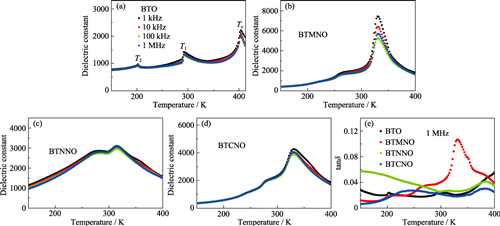
|
|
|
Ablation Behavior of Ultra-high Temperature Composite Ceramic Matrix Composites
JU Yinchao, LIU Xiaoyong, WANG Qin, ZHANG Weigang, WEI Xi
2022 Vol. 37 (1): 86–92
 Abstract
Abstract(
919 )
 HTML
HTML(
59)
 PDF
PDF(8362KB)(
1576
)
Ultra-high temperature composite ceramic matrix composites ZrC-SiC, ZrB2-ZrC-SiC and HfB2-HfC-SiC were fabricated by precursor infiltration and pyrolysis method. The ultra-high temperature ceramic phases in the materials were characterized by submicron/ nanometer uniform dispersion distribution. Ablation behaviors of ZrC-SiC, ZrB2-ZrC-SiC and HfB2-HfC-SiC matrix composites under atmospheric plasma and on-ground arc-jet wind tunnel were investigated comparatively. The main factors that affect design for ultra-high temperature composite ceramic matrix composites were summarized. The result shows that, compared with traditional SiC-based composites, ultra-high temperature composite ceramic matrix composites have a solid-liquid two-phase dense oxide film formed in situ on the surface of the composites after ablation. Synergistic effect of the two phases has achieved effects of erosion resistance and oxidation resistance, which plays a very important role in hindering the loss of liquid SiO2 and greatly improves the ultra-high temperature ablation performance of the materials. On this basis, the important factors that should be considered in the matrix design of ultra-high temperature composite ceramic matrix composites are obtained. The above results have instructional significance for the ultra-high temperature and the limited life application of ceramic matrix composites.
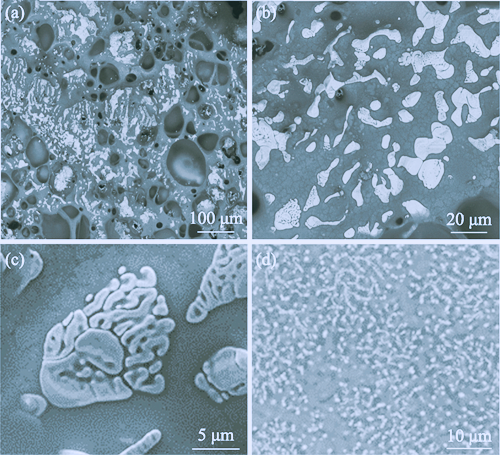
|
|
|
Infrared Radiation Shielded SiZrOC Nanofiber Membranes: Preparation and High-temperature Thermal Insulation Performance
ZHANG Xiaoshan, WANG Bing, WU Nan, HAN Cheng, LIU Haiyan, WANG Yingde
2022 Vol. 37 (1): 93–100
 Abstract
Abstract(
555 )
 HTML
HTML(
31)
 PDF
PDF(9901KB)(
1075
)
Ceramic fibers are the vital high-temperature thermal insulating materials due to their excellent mechanical property, high-temperature stability and thermal shock resistance. However, practical application of traditional ceramic fiber membranes in the field of thermal insulation are greatly limited by their high thermal conductivities at high-temperatures. In this work, SiZrOC nanofiber membranes with high infrared shielding performance were prepared by electrospinning technique. The SiZrOC nanofibers were composed of SiO2, ZrO2, SiOC, and free carbon phase with average diameter of (511±108) nm. The SiZrOC nanofiber membranes exhibited possess excellent high-temperature thermal insulation performance. Thermal conductivity of SiZrOC nanofiber membranes at 1000 ℃ reached 0.127 W·m-1·K-1, obviously lower than that of other traditional ceramic fibers. In addition, the as-prepared SiZrOC nanofiber membranes exhibited high strength, good flexibility and excellent high-temperature stability, so they had great potential for high-temperature thermal insulation. Therefore, preparation strategy of SiZrOC nanofiber membranes also provides a new route for designing other high-performance thermal insulators.
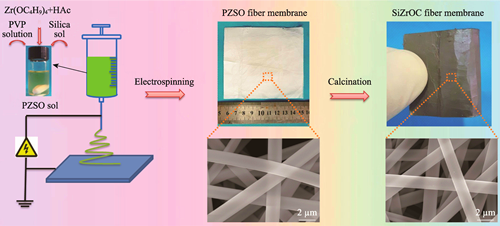
|
|
|
Metal Sulfide Ag2S: Fabrication via Zone Melting Method and Its Thermoelectric Property
JIN Min, BAI Xudong, ZHANG Rulin, ZHOU Lina, LI Rongbin
2022 Vol. 37 (1): 101–106
 Abstract
Abstract(
433 )
 HTML
HTML(
27)
 PDF
PDF(2052KB)(
932
)
Metal sulfide Ag2S is an attractive semiconductor due to its excellent physical and chemical property that enable it with wide applications in fields of catalysis, sensing, optoelectronics in past years. In present work, ϕ18 mm× 50 mm Ag2S ingot was successfully prepared using zone melting method and its thermoelectric (TE) behavior was investigated. Ag2S has standard monoclinic P21/c space group (α-Ag2S phase) below 450 K and transfer to cubic structure (β-Ag2S phase) over this temperature. Ag2S is a n-type semiconductor as the Seebeck coefficient S is always negative due to the Ag interstitial ions in the material that can provide additional electrons. S is about -1200 µV·K-1near room temperature, declines to -680 µV·K -1 at 440 K and finally decreases to ~-100 µV·K -1at β-Ag2S state. The electrical conductivity (σ) of α-Ag2S is almost zero. However, the value sharply jumps to ~40000.5 S·m -1 as the material just changes to β-Ag2S at 450 K and then gradually deceases to 33256.2 S·m -1 at 650 K. Hall measurement demonstrates that carrier concentration nH of Ag2S is suddenly increased from the level of ~10 17 cm-3 to ~1018 cm-3during phase transition. Total thermal conductivity κ of α-Ag2S is ~0.20 W·m -1·K-1 but is ~0.45 W·m-1·K-1of β-Ag2S. Ultimately, a maximum ZT=0.57 is achieved around 580 K that means Ag2S might be a promising middle-temperature TE material.

|
|
|
Advanced Multi-laser-beam Parallel Heating System for Rapid High Temperature Treatment
XU Xiaoke, DENG Mingxue, LIU Qian, YU Jianding, ZHOU Zhenzhen, ZHANG Xiang, HE Huan
2022 Vol. 37 (1): 107–112
 Abstract
Abstract(
378 )
 HTML
HTML(
18)
 PDF
PDF(2488KB)(
767
)
Rapid and high-throughput experimental methods are of great significance to the development of material genetic engineering technology. High temperature heat treatment is a necessary part for the preparation of inorganic non-metallic materials, while the rapid heat treatment technology of materials library needed for material genetic engineering is still blank. Here we report the multi-laser-beam parallel heating system which can be used in rapid high temperature treatment for samples arranged in an array of {A´B}, named as materials library. We introduce the design principle, operation mode, structure details, and software of the multi-laser-beam parallel heating system. The facility presents many advantages of independent adjustment of laser heating time, power and spot size for each beam and high automation. The maximum laser power is above 100 W, and the maximum stable heating temperature is ~2000 ℃ for each laser beam. As a typical application demonstration, a series of sintering experiments of Y3Al5O12:Ce (YAG:Ce) luminescent ceramics were carried out. Their heating temperature was 1400 ℃, 1500 ℃ and 1600 ℃, while their holding time was 180, 360 and 540 s, respectively. Above facility operated automatically according to the pre-set heating positions and heating curves. All results show that, using the multi-laser-beam parallel heating system, fully-sintered samples with good crystallinity and luminescence properties can be obtained within several minute heat treatment, while the conventional sintering technology needs more than 10 h. This study may provide a new technical solution for processing condition screening and high-throughput preparation of multi-samples in an energy and time saving mode.
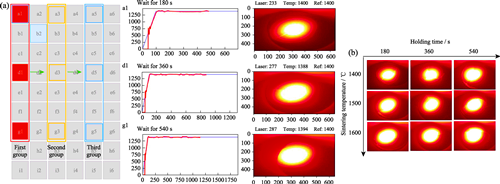
|
|